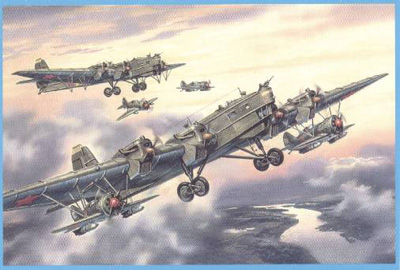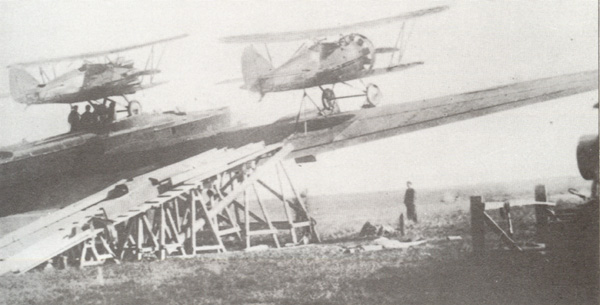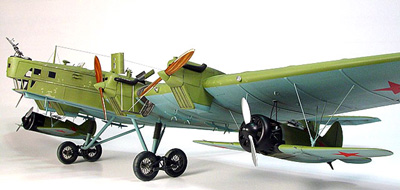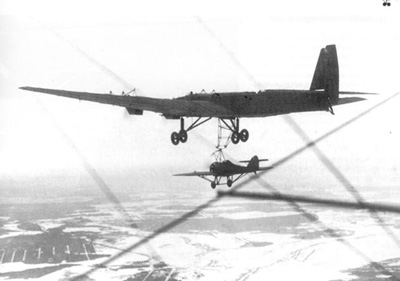| The Vakhmistrov Zveno One of the Strangest Airplanes That Ever Took to the Air by Raul Colon |

| ||
|---|---|---|---|
| Home Page | Articles Index | The Zveno composite bomber/fighter designed by Vladimir Vakhmistrov. | |

|
|||
|
One of the most strange and bizarre looking aircraft that ever took to the air has to be the Zveno composite bomber/fighter design by Vakhmistrov. The concept first took shape in the mid-twenties, when the Soviet Air Force were looking at ways to both, shoot down incoming enemy bombers and to supplement the ground troops in the battlefield. Many new concepts and designs came forward, but the most intriguing to the Tupolev Bureau of Aircraft Design, was the Zveno. The concept was fairly straight forward. Utilizing the largest bomber of its day, the massive TB-3, different combination of fighters and dive-bombers were attached to its fuselage and wings, to provide the bomber with its own defensive capabilities.
After experiments conducted with gliders attached to the "mother ship", the Polikarpov R-1, designer Vladimir Vakhmistrov proposed a radical new concept that eventually developed into one of the world's first "parasite" configurations. In the late twenties, Vakhmistrov persuaded the then infant Soviet Air Force, that a heavy bomber can carry fighters for its own protection and release them when necessary, and also produce a ground attack aircraft capability. The first of these combinations, named the Zveno 1 or Z-1, involved carrying a modified I-4 fighter above each wing. The airplane was place in position using wooden ramps and ropes to haul them onto the wing. The initial trials proved successful and, after the design had been adapted to carry the larger I-5 fighters, the bomber designation change to Z-1a. The Z-2 consisted of a TB-3 with three I-5s, one on each wing, and a third above the fuselage. The TB-3 proved to be an excellent carrier platform. The next model, the even more ambitious Z-5 featured a Grigorovich I-Z suspended beneath the TB-3 on a steel trapeze. The airplane could then be recovered after their release using a system similar to that used by the Curtiss F9C. |
 |
|
The Z-2 employed ramps to load Polikarpov I-5 fighters onto the wings. |
| The TB-3 had four 819 hp Mikulin AM-34-RN piston engines as power plants. It had a maximum speed of 152 mph—a major feat for this kind of unorthodox aircraft. The engines gave the TB-3 a climb rate of 410 ft/min. to 3,280ft. The range of the aircraft was some 620 miles and had a service ceiling of 25,400 ft. Its maximum take-off weight was 41,529 lbs, with a wing span of 137 ft, 1 in, length of 82 ft 4 in and a wing area of 2,523 sq. ft. The TB-3's main armament, apart from its fighter "parasites" was two 7.62 mm machine guns, one mounted on the nose and the other in the tail position, plus two more machine guns of the same caliber in the dorsal and ventral positions. The original Zveno Z-1 first took to the air with Vakhmistrov on December 3rd, 1931 at Monino. The first successful in-flight release of all five units occurred on November 1935. |
 |
|
|
The Z-7, carried two Polikarpov I-16SPB fighters below the wings. | |
|
The pilot of the TB-3 bomber had the difficult task of keeping the "mother ship" as steady as possible during the extremely difficult release sequence. The airplanes on the wing were released simultaneously to prevent the dangerous asymmetrical situation of having an aircraft on one wing, but not on the other. The aircraft was extremely unmanoeuvrable when all aircraft were attached. The co-pilot was assigned the task of releasing the main axel attachment on the I-5 fighter, once the pilot had released the rear fixture. The fighter above each wing of the Zveno was the Polikarpov I-5 model, secured by a hold-down undercarriage and a steel tripod fixture attached to the Zveno's wing. An I-16 fighter plane was attached beneath each wing. Each of one was held in position by a two large V-struts made from aluminum tubing. Suspended beneath the bomber fuselage, on a steel tube trapeze, was the I-Z fighter, the only aircraft that could be recovered after it had launched from the "mother ship". The I-Z had s steel structure with a sprung hook in the front of the pilot's cockpit, which the pilot guided into the trapeze.
The culmination of the design process was the still incredible Aviamatka Z-6, which carried two planes I-5 fighters above the wings, two I-16s below the wings and an I-Z on the trapeze. Unexpectedly, the final combination, the Z-7, saw service during the early years of the Great Patriotic War (WW II), carrying two I-16SPB dive-bombers and it made one famous mission, bombing and destroying a bridge at the Danube in Chyernovod, Romania. After the TB-3, other major aircraft companies had tried out with composite aircraft designs. One of the most famous designs was the Curtiss F9C Sparrowhawk that was attached to the airships USS Macon and USS Akron and were recovered by the "mother ship" utilizing a trapeze system. Another design was the late 1945 Luftwaffe experiment of using a Ju 88 as a flying bomb guided by an attached single fighter— the experiments were never carried out in major phases. The last attempt to use a composite system was the use of the US Air Force Convair B-36 Peace-Maker bomber as a "mother ship" with a YF-84F reconnaissance aircraft under the fuselage, or joined at the wingtips. Again, as in the other programs, they never make it to the operational phase status. |
 |
|
|
The Z-5 carried a Grigorovich I-Z beneath the TB-3 on a steel trapeze. | |
Sources
|
* Concept Aircrafts: Prototypes, X-Planes, and Experimental Aircrafts. Editor Jim Winchester. ThunderBay Press – 2005 * Soviet X-Planes. Yefim Gordon and Bill Guston. Midland Publishing 2000 * Russian Aviation and Air Power in the Twentieth Century. Edited Robin Higman, John Greenwood, and Von Hardesty, Frank Cass 1998 * Axis Aircraft of World War II. David Mondey. Smithmark Publishers, 1996. * German Military Aircraft. Bryan Philpott. Crescent Books, 1981. * The History of Soviet Aircraft from 1918. Vaclev Nemecek. Willow Books, 1986. * World Aircraft 1918-1935. Enzo Angelucci and Paolo Matricardi. Rand Mcnally, 1976. * Polikarpov Fighters in Action Part I. Hans-Heiri Stapfer, Don Greer and Joe Sewell. Squadron Signal Publications, 1995. * Polikarpov Fighters in Action Part II. Hans-Heiri Stapfer, Don Greer, Ernesto Cumpian and Joe Sewell. Squadron Signal Publications, 1995. * Russian Fighter Aircraft 1920-1941. Heinz J. Nowarra. Schiffer Military History, 1997. |
|
The author Paul Colon is a freelance writer who resides in San Juan Puerto Rico. rcolonfrias@yahoo.com |
Return To Articles Index.
© The Aviation History On-Line Museum.
All rights reserved.
October 21,2007.